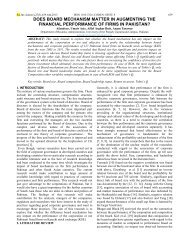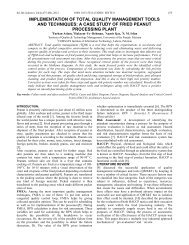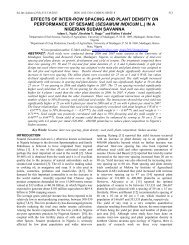a survey of the chemical constituents and biological ... - Sci-int.com
a survey of the chemical constituents and biological ... - Sci-int.com
a survey of the chemical constituents and biological ... - Sci-int.com
You also want an ePaper? Increase the reach of your titles
YUMPU automatically turns print PDFs into web optimized ePapers that Google loves.
<strong>Sci</strong>..Int.(Lahore),24(2),133-138,2012 ISSN 1013-5316; CODEN: SINTE 8 133A SURVEY OF THE CHEMICAL CONSTITUENTS ANDBIOLOGICAL ACTIVITIES OF ORTHOSIPHON STAMINEUS*Yen Chin Koay <strong>and</strong> Faheem AmirSchool <strong>of</strong> Chemical <strong>Sci</strong>ences, Universiti Sains Malaysia, Penang 11800, Malaysia(*yckoay.86@gmail.<strong>com</strong>)ABSTRACT: For centuries, Orthosiphon stamineus Benth, a native plant to Sou<strong>the</strong>ast Asia, has beenextensively used as a source <strong>of</strong> medicinal agents due to its wide range <strong>of</strong> medicinal properties. It isusually consumed as a herbal tea <strong>and</strong> it was believed to be useful in <strong>the</strong> treatment <strong>of</strong> diabetes, fevers,high blood pressure <strong>and</strong> bone or muscular pain, hypertension, kidney stone as well as promotinghealth <strong>and</strong> well being. The plant has also been reported to possess various novel secondarymetabolites such as diterpenes, flavones <strong>and</strong> triterpene. This review summarizes <strong>the</strong> phyto<strong>chemical</strong>investigations <strong>and</strong> pharmacological properties <strong>of</strong> O. stamineus.Keyword: Orthosiphon stamineus, diterpenes, flavones, antibacterial, anti-inflammatory1. INTRODUCTIONOrthosiphon stamineus Benth (Lamiaceae) [syn: O. aristatus(B1) Miq., O. gr<strong>and</strong>iflorus Bold., O. spicatus (Thumb)] orlocally known as ‘‘cat whisker”, is a medicinal herb whichhave ethnomedicinal applications in South East Asia,particularly Malaysia <strong>and</strong> Indonesia. Historically, this herbwere used as a traditional folk medicine for <strong>the</strong> treatment <strong>of</strong>diabetes, edema, epilepsy, eruptive fever, gallstones,hepatitis, hypertension, renal stones, as well as rheumatism[1-3]. An infusion <strong>of</strong> <strong>the</strong> leaves has been reported to possessdiuretic, anti-fungal, anti-inflammatory, anti-hypertensive<strong>and</strong> antibacterial properties [4-7]. The leaves are also foundto possess significant antioxidant activity <strong>and</strong> <strong>the</strong> lipophilicflavonoids from <strong>the</strong> plant were found to prevent <strong>the</strong>oxidative inactivation <strong>of</strong> 15-lipoxygenase [8-9].2. Isolation <strong>and</strong> <strong>chemical</strong> investigationThe earliest phyto<strong>chemical</strong> investigation on O. stamineusstarted in 1989, when Guerin et al. isolated an oil, namely,methylripariochromene A from <strong>the</strong> plant [10].Phyto<strong>chemical</strong> investigation <strong>of</strong> <strong>the</strong> dry leaves <strong>of</strong> O.stamineus has led to <strong>the</strong> isolation <strong>of</strong> two novel highlyoxygenated pimarane diterpenes, orthosiphols A ( 1), B ( 2)(Figure 1) [11]. Takeda et al. reported <strong>the</strong> presence <strong>of</strong> twonew diterpenes, orthosiphols D (3) <strong>and</strong> E (4), toge<strong>the</strong>r withseven known <strong>com</strong>pounds, namely, rosmarinic acid,sinensetin, scutellarein tetramethyl e<strong>the</strong>r, salvigenin,orthosiphols A <strong>and</strong> B [12]. Four novel highly oxygenatedisopimarane-type diterpenes, namely, siphonols A-D ( 5-8)<strong>and</strong> a novel biogenetically <strong>int</strong>eresting norisopimarane-typediterpene named siphonol E ( 9) were isolated from O.stamineus <strong>of</strong> Indonesia [2].Olah et al. revealed <strong>the</strong> presence <strong>of</strong> caffeic acid, cichoricacid rosmarinic acid, sinesetine <strong>and</strong> patorine from twodifferent O. stamineus tinctures [6]. Phyto<strong>chemical</strong>investigations <strong>of</strong> <strong>the</strong> aerial parts <strong>of</strong> Taiwanese O. stamineusby Nguyen et al. reported <strong>the</strong> isolation <strong>of</strong> two newstaminane-type diterpenes, staminol C ( 10) <strong>and</strong> D ( 11)(Figure 2), three new isopimarane-type diterpenes identifiedas orthosiphonone C ( 12) <strong>and</strong> D ( 13), <strong>and</strong> 14-deoxo-14-OacetylorthosipholY ( 14), along with <strong>the</strong> presence <strong>of</strong> 16known diterpenes, orthosiphols A, B, D, K, M, N, O, X, <strong>and</strong>Y, nororthosiphonolide A, neoorthosiphol B, orthosiphononeA, secoorthosiphol B <strong>and</strong> C, 3-O-deacetylorthosiphol I, <strong>and</strong>2-O-deacetylorthosiphol J [13].Akowuah et al. <strong>and</strong> Loon et al. reported <strong>the</strong> presence <strong>of</strong>three methoxylated flavones, namely, sinensetin, eupatorin<strong>and</strong> 3’-hydroxy-5,6,7,4’-tetramethoxyflavone from <strong>the</strong>methanolic leaves extracts <strong>of</strong> O. stamineus <strong>of</strong> Malaysia.Akowuah et al. also reported <strong>the</strong> presence <strong>of</strong> rosmarinic acidfrom <strong>the</strong> leaves [9,14].Hossain & Ismail isolated a new lupene-type triterpene,namely 16β-hydroxybetulinic acid (15) (Figure 3) from <strong>the</strong>leaves <strong>of</strong> O. stamineus [15]. Hossain et al. isolated apolyhydroxyflavone, namely, 5,7,3',4'-tetrahydroxy-thoxyflavone from <strong>the</strong> leaves <strong>of</strong> O. stamineus [16].
134ISSN 1013-5316; CODEN: SINTE 8<strong>Sci</strong>..Int.(Lahore),24(2),133-138,2012Figure 2. Compounds 10-14Figure 1. Compound 1-9Figure 3. Compound 15The examination <strong>of</strong> <strong>the</strong> hydrodistilled essential leaves <strong>and</strong>stems oils <strong>of</strong> O. stamineus revealed <strong>the</strong> presence <strong>of</strong> β-caryophyllene, α-humulene, β-elemene, 1-octen-3-ol, β-bourbonene, β-pinene, caryophyllene oxide, camphene <strong>and</strong>limonene as major <strong>com</strong>ponents which were analysed by GC-MS [17]. Mohamed et al. isolated orthosiphol A from <strong>the</strong>extract <strong>of</strong> O. stamineus leaves using <strong>the</strong> reverse phase highperformance liquid chromatography (RP -HPLC) with UVdetection [3].3. Phyto<strong>chemical</strong> investigations with bio‐activityThe presence <strong>of</strong> five new isopimarane-type diterpenes[orthosiphols F-J (16-20)] (Figure 4) <strong>and</strong> two new diterpenes[staminols A (21) <strong>and</strong> B (22)], as well as three new highlyoxygenatedstaminane-type diterpenes [staminolactones A(23) <strong>and</strong> B (24) <strong>and</strong> norstaminol A (25)] were reported from<strong>the</strong> methanol extract <strong>of</strong> <strong>of</strong> O. stamineus [18-20]. 16 known
<strong>Sci</strong>..Int.(Lahore),24(2),133-138,2012 ISSN 1013-5316; CODEN: SINTE 8 135<strong>com</strong>pounds identified as 7, 3’, 4’-tri-O-methylluteolin,eupatorin, sinensetin, 5-hydroxy-6, 7, 3’, 4’-tetramethoxyflavone, salvigenin, ladanein,tetramethylscutellarein, 6-hydroxy-5, 7, 4’-trimethoxyflavone,vomifoliol, aurantiamide acetate, rosmarinic acid,caffeic acid, oleanolic acid, ursolic acid, betulinic acid <strong>and</strong>β-sitosterol were also isolated from <strong>the</strong> methanol extract <strong>of</strong>O. stamineus [19-20]. Tezuka et al. reported that all <strong>the</strong><strong>com</strong>pounds isolated, except for orthosiphol I, 7, 3’, 4’-tri-Omethylluteolin,eupatorin, ladanein <strong>and</strong> 6-hydroxy-5, 7, 4’-trimethoxy-flavone exhibited a promising cytotoxic effect onhighly liver metastatic murine colon 26-L5 carcinoma cells[20].Figure 4. Compounds 16-25Awale et al. also isolated six new highly oxygenatedisopimarane-type diterpenes, namely, orthosiphols U-Z (26-31) ( Figure 5) toge<strong>the</strong>r with 15 previously reportedditerpenes. All <strong>the</strong> isolated diterpenes indicated significantdose-dependent inhibitory effects on <strong>the</strong> nitric oxide (NO)production in lipopolysaccharide (LPS) -activatedmacrophage-like J774.1 cells [21].Hossain & Ismail isolated two new prenylated flavonoidderivatives, namely, 5,7,3',5'-tetramethoxy-8-C-prenylflavone(32) (Figure 6) <strong>and</strong> 5,7,3',5'-tetramethoxy-6-Cprenylflavone(33), along with four known flavonoids5,6,7,3',4'-pentamethoxyflavone,5-hydroxy-6,7,3',4'-tetramethoxyflavone, ladanein <strong>and</strong> 6-hydroxy-5,7,4'-trimethoxyflavone isolated from <strong>the</strong> leaves extracts <strong>of</strong> O.stamineus. The two new prenylated flavones, toge<strong>the</strong>r with<strong>the</strong> four known flavonoids displayed a promising cytotoxiceffect on liver metasttatic murine colon 26-L5 carcinomacells with an ED 50 value between 10-90 μg/mL [22].
136ISSN 1013-5316; CODEN: SINTE 8<strong>Sci</strong>..Int.(Lahore),24(2),133-138,2012Figure 5. Compounds 26-314. Biological activities4.1 Adenosine A1 receptor binding assayYuliana et al. isolated seven methoxy flavonoids from amethanol-water extract <strong>of</strong> O. stamineus leaves through <strong>the</strong>bioassay-guided fractionation using adenosine A1 receptorbinding assay, whereby <strong>the</strong> adenosine A1 receptor bindingwere associated with <strong>the</strong> diuretic action in <strong>the</strong> treatment forrenal lithiasis. The findings <strong>of</strong> this study thus fur<strong>the</strong>r validate<strong>the</strong> traditional use <strong>of</strong> O. stamineus for kidney stonestreatment [23].4.2 Antibacterial activityThe studies conducted by Ho et al. showed that <strong>the</strong>promising antibacterial <strong>of</strong> O. stamineus extracts againstselected food-borne bacteria in vitro were attributable to <strong>the</strong>presence <strong>of</strong> rosmarinic acid in <strong>the</strong> plant [24].Figure 6. Compounds 32 <strong>and</strong> 334.3 Anti-hyperglycemic effectInvestigations were carried out to evaluate <strong>the</strong> effect <strong>of</strong>leaves extract <strong>of</strong> O. stamineus on streptozotocin (STZ) -induced diabetic rat <strong>and</strong> <strong>the</strong> chlor<strong>of</strong>orm fraction 2 (Cf2) wasfound to significantly reduced <strong>the</strong> blood glucose level onglucose-loaded fasting rats <strong>of</strong> 150 mg/kg body weight [3].4.4 Antihypertensive activityThe oral administration <strong>of</strong> O. staminensis toge<strong>the</strong>r with <strong>the</strong><strong>com</strong>bination <strong>of</strong> policosanol, red yeast rice extract, berberine,folic acid <strong>and</strong> coenzyme Q 10 have indicated an effectivecontrol <strong>of</strong> high blood pressure in patients with metabolicsyndrome, thus may be served as a antihypertensive agent[25].4.5 Anti-inflammatory activityMasuda et al. reported <strong>the</strong> isolation <strong>of</strong> orthosiphol A <strong>and</strong> Bshowed strong inhibitory activity against <strong>the</strong> inflammationinduced by a tumor promoter, TPA (12 -Otetradecanoylphorbol-13-acetate)on <strong>the</strong> ears <strong>of</strong> genetargetedmice [11].4.6 Antioxidant activityFree-radical scavenging activity <strong>and</strong> superoxide inhibitionactivity <strong>of</strong> <strong>the</strong> methanol extract <strong>of</strong> O. stamineus wereexamined using <strong>the</strong> DPPH radical method <strong>and</strong> nonenzymePMS/NADH-NBT systems <strong>and</strong> <strong>the</strong> methanol extract wasfound to exhibit <strong>com</strong>parable antioxidant activity than purequercetin <strong>and</strong> higher antioxidative potency than <strong>the</strong> syn<strong>the</strong>ticantioxidant butylated hydroxylanisole (BHA) [26-27].Yam et al. <strong>and</strong> Ho et al. reported that <strong>the</strong> O. stamineusextracts possessed high high antioxidant activity <strong>of</strong> O.stamineus extracts determined by <strong>the</strong> DPPH free radicalscavenging assay, whereby Ho et al. [24] suggested <strong>the</strong>
<strong>Sci</strong>..Int.(Lahore),24(2),133-138,2012 ISSN 1013-5316; CODEN: SINTE 8 137presence <strong>of</strong> high concentration <strong>of</strong> rosmarinic acid in <strong>the</strong> O.stamineus extracts were associated with <strong>the</strong> high antioxidantactivity <strong>of</strong> O. stamineus extracts [24,28].4.7 Anti-proliferative activitySahib et al. reported <strong>the</strong> methanolic extract <strong>of</strong> O. stamineuswhen <strong>com</strong>bined with Tamoxifen (TMX), an antagonist <strong>of</strong><strong>the</strong> estrogen receptor (ER+) in breast tissue, fur<strong>the</strong>r enhance<strong>the</strong> anti-proliferative activity <strong>of</strong> TMX against MCF-7hormone responsive breast cancer cells in vitro as <strong>com</strong>paredto <strong>the</strong> activity <strong>of</strong> singly treated TMX [29].4.8 Anti-pyretic activityAnti-pyretic effect <strong>of</strong> <strong>the</strong> st<strong>and</strong>ardized methanol/water(50/50) extract <strong>of</strong> O. stamineus were investigated at doses <strong>of</strong>500 <strong>and</strong> 1000 mg/kg body weight using yeast-inducedpyrexia in Sprague Dawley (SD) rats. Administration <strong>of</strong> <strong>the</strong>extract produced significant reduction in <strong>the</strong> bodytemperature <strong>of</strong> <strong>the</strong> yeast-induced pyrexia rats. Thus <strong>the</strong>results in <strong>the</strong> study suggested <strong>the</strong> extract <strong>of</strong> O. stamineuspossessed potent any-pyretic properties [30].4.9 Antitumor <strong>and</strong> antiangiogenic activityAbdul Majid et al. reported that phyto<strong>chemical</strong> <strong>and</strong>pharmacology <strong>com</strong>ponents <strong>com</strong>prising st<strong>and</strong>ardized O.stamineus leaf extract was found to prevent or treat diseasesassociated with angiogenesis <strong>and</strong> maglignant tumors. The<strong>com</strong>ponents with <strong>the</strong> presence <strong>of</strong> st<strong>and</strong>ardized O. stamineusleaf extract may also <strong>com</strong>prised <strong>com</strong>ponents that possessanti-angiogenic, anti-cancer, anti-inflammatory <strong>and</strong> antiagingproperties [31].Ahamed et al. also investigated antitumor effect <strong>of</strong> <strong>the</strong>ethanol extract <strong>of</strong> O. stamineus leaves athymic mice bearingcolorectal tumor <strong>and</strong> antiangiogenic activity wasinvestigated by measuring <strong>the</strong> tube formation <strong>of</strong> humanumbilical vein endo<strong>the</strong>lial cells (HUVECs). Administration<strong>of</strong> <strong>the</strong> extract at 100 mg/kg <strong>and</strong> 200 mg/kg, significantlysuppressed <strong>the</strong> tumor growth by 47.62 ± 6.4% <strong>and</strong> 83.39 ±4.1%, respectively. The expression <strong>of</strong> vascular endo<strong>the</strong>lialgrowth factor (VEGF) in vitro along with in vivo weresignificantly inhibited at 211 ± 0.26 pg/mL cell lysate <strong>and</strong>90.9 ± 2 pg/g tissue homogenate when <strong>com</strong>pared to <strong>the</strong>control (378 ± 5 <strong>and</strong> 135.5 ± 4 pg, resp.) at 200 mg/kg. Theresults fur<strong>the</strong>r validate <strong>the</strong> use <strong>of</strong> O. stamineus for treating avariety <strong>of</strong> angiogenesis-dependent diseases [32].4.10 Cardioprotective activityThe cardioprotective studies methanol extract <strong>of</strong> O.stamineus leaves based on <strong>the</strong> bio<strong>chemical</strong> parameters inisoproterenol induced myocardial infarction in ratssuggested methanol extract <strong>of</strong> O. stamineus leaves protectedmyocardium from isoproterenol-induced myocardialfunctional injury via normalization levels <strong>of</strong> diagnosticmarker enzymes. This study indicated O. stamineus has <strong>the</strong>potential to be used as natural cardioprotective agent [33].4.11 Diuretic <strong>and</strong> hypouricemic activitiesThe study <strong>of</strong> diuretic <strong>and</strong> hypouricemic activity <strong>of</strong> differentO. stamineus methanol extracts were conducted by Arafat etal. using Sprague-Dawley rats model. The infusion <strong>of</strong> asingle dose (2 g/kg) <strong>of</strong> methanol <strong>and</strong> methanol : water (1:1)extracts possesses important diuretic action, where <strong>the</strong> effectis quantitatively similar to <strong>the</strong> control, hydrochlorothiazide.Repeated administration <strong>of</strong> 0.5 g/kg <strong>of</strong> methanol : water(1:1) extracts showed an increase in diuresis from <strong>the</strong> thirdday <strong>of</strong> treatment. Oral administration <strong>of</strong> 0.5, 1.0 <strong>and</strong> 2.0 g/kg<strong>of</strong> methanol : water (1:1) extracts significantly reduced <strong>the</strong>serum urate level in hyperuricemic rats at hour 6, whereby<strong>the</strong> decrease in <strong>the</strong> uric acid level was also observed for <strong>the</strong>st<strong>and</strong>ard, allopurinol at hour 6. These results suggested <strong>the</strong>potency <strong>of</strong> O. stamineus methanol : water extracts towardsdiuretic property <strong>and</strong> hypouricemic activity [34].4.12 Inhibiion <strong>of</strong> CYP enzymesPan et al. examined <strong>the</strong> effects <strong>of</strong> four O. stamineus extracts<strong>and</strong> three isolated <strong>constituents</strong> sinensetin, eupatorin <strong>and</strong>rosmarinic acid on on major human cDNA-expressedcytochrome P 450 (CYP) enzymes. Three substrate -probebased HPLC (high -performance liquid chromatography)assays were established to serve as activity markers forCYP2C9, CYP2D6 <strong>and</strong> CYP3A4. The extracts <strong>and</strong> isolated<strong>constituents</strong> showed differential modulatory effects ondifferent CYPs <strong>and</strong> none <strong>of</strong> isolated <strong>constituents</strong> showed anysignificant inhibition on CYP2C9, eupatorin stronglyinhibited CYP2D6 activity with a K i value <strong>of</strong> 10.2 μM,while CYP3A4 was moderately inhibited by <strong>the</strong> petroleume<strong>the</strong>r <strong>and</strong> dichloromethane extracts with K i values <strong>of</strong> 44.9<strong>and</strong> 93.7 μg/mL, respectively. The activity was found to bedue to <strong>the</strong> presence <strong>of</strong> eupatorin in <strong>the</strong> extracts. CYP3A4was also strongly inhibited by eupatorin alone, with a K ivalue <strong>of</strong> 9.3 μM. Thus it was suggested that coadministration<strong>of</strong> products based on O. stamineus extractswith high eupatorin content, with conventional drugs mayhave <strong>the</strong> potential to cause drug-herb <strong>int</strong>eractions involvinginhibition <strong>of</strong> major CYP enzymes [35].4.13 In vitro antimycobacterial activityHussain et al. investigated <strong>the</strong> antimycobacterial activity <strong>of</strong><strong>the</strong> aqueous extract as well as <strong>the</strong> fractions <strong>of</strong> O. stamineus<strong>and</strong> evaluated <strong>the</strong> potential <strong>int</strong>eraction <strong>of</strong> <strong>the</strong> plant withisoniazid (INH). The aqueous extracts, hexane fraction,chlor<strong>of</strong>orm fraction, ethyl acetate fraction indicatedminimum inhibitory concentrations <strong>of</strong> 25.00, 3.12, 6.25 <strong>and</strong>0.39 μg/mL, respectively. The results showed <strong>the</strong>re was nostatistically significant <strong>int</strong>eraction being observed for <strong>the</strong><strong>com</strong>binations <strong>of</strong> <strong>the</strong> extracts along with <strong>the</strong> fractions withINH in various proportions, thus no significant <strong>int</strong>eraction <strong>of</strong>between <strong>the</strong> aqueous extract <strong>and</strong> INH was observed [36].4.14 Nephroprotective activityKannappan et al. have evaluated nephroprotective activity <strong>of</strong>O. stamineus benth extracts using rat model. Gentamycin, anextensively used aminoglycoside antibiotic, has beenreported to produce nephrotoxicity even at normal<strong>the</strong>rapeutic dose level. Oral administration <strong>of</strong> <strong>the</strong> drug at adose <strong>of</strong> 80 mg/kg weight for 9 days showed markedglomerular, peritubular <strong>and</strong> blood vessel congestion asindicated by <strong>the</strong> histopathological sections. Administratedmethanolic extract <strong>of</strong> O. stamineus at 100 <strong>and</strong> 200 mg/kgbody weight doses in rats <strong>and</strong> found a remarkable decreasein serum creatinine, blood urea, urinary protein levels <strong>and</strong>reduced <strong>the</strong> extent <strong>of</strong> renal damage [37].4.15 5-α reductase activityVogelgesang et al. indicated <strong>the</strong> presence <strong>of</strong> O. stamineusleaf extract as a main ingredient in cosmetic products canreduced <strong>the</strong> skin imperfection associated to excessive sebumsecretion. O. stamineus leaf extract was also found topossess <strong>the</strong> ability to reduce 5-α reductase, particular type 1isoenzyme in normal human epidermal keratinocytes in vitro<strong>and</strong> when applied to ex vivo skin reduces 5-α reductase
138activity as well as squalene, which is one <strong>of</strong> <strong>the</strong> main<strong>com</strong>ponents <strong>of</strong> sebum [38].REFERENCES1. Mat-Salleh, K.; Latiff, A. Tumbuhan Ubatan Malaysia;Bangi: Universiti Kebangsaan Malaysia, 2002.2. Awale, S.; Tezuka, Y.; Banskota, A. H.; Kadota, S.Bioorganic & Medicinal Chemistry Letters, 13,312003.3. Mohamed, E. A. H.; Mohamed, A. J.; Asmawi, M. Z.;Sadikun, A.; Ebrika, O. S.; Yam, M. F. Molecules, 16,3787, 2011.4. Tiktinskii, O.; Bablumian, I. Urol Nefrol (Mosk) , 3, 47,1983.5. Ohashi, K.; Bohgaki, T.; Shibuya, H. Yakugaku Zasshi,120, 474, 2000.6. Olah, N. K.; Radu, L.; Mogosan, C.; Hanganu, D.; Gocan,S. Journal <strong>of</strong> Pharmaceutical <strong>and</strong> Biomedical Analysis,33, 117, 2003.7. Liang, L. F.; Keng, C. L.; Lim, B. P. In Vitro Cellular &Developmental Biology-Plant, 42, 538, 2006.8. Lyck<strong>and</strong>er, I. M.; Malterud, K. Prostagl<strong>and</strong>ins,leukotrienes <strong>and</strong> essential fatty acids, 54, 239, 1996.9. Loon, Y. H.; Wong, J. W.; Yap, S. P.; Yuen, K. H.Journal <strong>of</strong> Chromatography B 816, 161, 2005.10. Guerin, J. C.; Reveillere, H. P.; Ducrey, P.; Toupet, L.Journal <strong>of</strong> Natural Products, 52, 171, 1989.11. Masuda, T.; Masuda, K.; Shiragami, S.; Jitoe, A.;Nakatani, N. Tetrahedron, 48, 6787, 1992.12. Takeda, Y.; Matsumoto, T.; Terao, H.; Shingu, T.;Futatsuishi, Y.; Nohara, T.; Kajimoto, T.Phytochemistry, 33, 411, 1993.13. Nguyen, M. T. T.; Awale, S.; Tezuka, Y.; Chien-Hsiung,C.; Kadota, S. Journal <strong>of</strong> Natural Products, 67, 654,2004.14. Akowuah, G. A.; Zhari, I.; Norhayati, I.; Sadikun, A.;Khamsah, S. M. Food Chemistry, 87, 559, 2004.15. Hossain, M. A.; Ismail, Z. Indian Journal <strong>of</strong> Chemistry,44, 436, 2005.16. Hossain, M. A.; Salehuddin, S. M.; Ismail, Z. IndianJournal <strong>of</strong> Natural Products, 23, 3, 2007.17. Hossain, M. A.; Ismail, Z.; Rahman, A.; Kang, S. C.Industrial Crops <strong>and</strong> Products, 27, 328, 2008.18. Stampoulis, P.; Tezuka, Y.; Banskota, A. H.; Tran, K.Q.; Saiki, I.; Kadola, S. Tetrahedron letters, 40, 4239,1999.19. Stampoulis, P.; Tezuka, Y.; Banskota, A. H.; Tran, K.Q.; Saiki, I.; Kadota, S. Organic Letters, 1, 1367, 1999.20. Tezuka, Y.; Stampoulis, P.; Banskota, A. H.; Awale, S.;Tran, K. Q.; Saiki, I.; Kadota, S. Chemical <strong>and</strong>Pharmaceutical Bulletin, 48, 1711, 2000.ISSN 1013-5316; CODEN: SINTE 8<strong>Sci</strong>..Int.(Lahore),24(2),133-138,201221. Awale, S.; Tezuka, Y.; Banskota, A. H.; Adnyana, I. K.;Kadota, S. Journal <strong>of</strong> Natural Products, 66, 255, 2003.22. Hossain, M. A.; Ismail, Z. Asian Journal <strong>of</strong>Biotechnology, 3, 200, 2011.23. Yuliana, N. D.; Khatib, A.; Link-Struensee, A. M. R.;Ijzerman, A. P.; Rungkat-Zakaria, F.; Choi, Y. H.;Verpoorte, R. Planta Medica, 75, 132, 2009.24. Ho, C. H.; Noryati, I.; Sulaiman, S. F.; Rosma, A. FoodChemistry, 122, 1168, 2010.25. Rozza, F.; de Simone, G.; Izzo, R.; De Luca, N.;Trimarco, B. High Blood Pressure & CardiovascularPrevention, 16, 177, 2009.26. Akowuah, G. A.; Zhari, I.; Norhayati, I.; Sadikun, A.Pharmaceutical Biology, 42, 629, 2005.27. Khamsah, S. M.; Akowah, G.; Zhari, I. Journal <strong>of</strong>Sustainability <strong>Sci</strong>ence <strong>and</strong> Management, 1, 14, 2006.28. Yam, M. F.; Basir, R.; Asmawi, M. Z.; Ismail, Z. TheAmerican Journal <strong>of</strong> Chinese Medicine, 35, 115, 2007.29. Sahib, H. B.; Ismail, Z.; Othman, N. H.; Majid, A. M. S.A. International Journal <strong>of</strong> Pharmacology, 5, 273,2009.30. Yam, M. F.; Ang, L. F.; Basir, R.; Salman, I. M.; Ameer,O. Z.; Asmawi, M. Z. Inflammopharmacology, 17, 50,2009.31. Abdul Majid, A. M. S.; Ismail, Z.; Sahib, H. B.; AhamedBasheer, M. K.; Aisha, A. F. A. PCT Int. Appl. 2011.32. Ahamed, M. B. K.; Aisha, A. F. A.; Nassar, Z. D.;Siddiqui, J. M.; Ismail, Z.; Omari, S. M. S.; Parish, C.R.; Majid, A. M. S. A. Nutrition <strong>and</strong> Cancer, 64, 89,2012.33. Maheswari, C.; Umadevi, M.; Anudeepa, J.; Ramya, R.;Narayanan, R. V. International Journal <strong>of</strong> Pharmacy &Technology, 3, 2896, 2011.34. Arafat, O. M.; Tham, S. Y.; Sadikun, A.; Zhari, I.;Haughton, P. J.; Asmawi, M. Z. Journal <strong>of</strong>Ethnopharmacology, 118, 354, 2008.35. Pan, Y.; Abd-Rashid, B. A.; Ismail, Z.; Ismail, R.; Mak,J. W.; Pook, P. C. K.; Er, H. M.; Ong, C. E. Chemico-Biological Interactions, 190, 1, 2011.36. Hussain, K.; Hashmi, F. K.; Hassan, S. S.; Latif, A.;Ismail, Z.; Sadikun, A.; Ibrahim, P. Latin AmericanJournal <strong>of</strong> Pharmacy, 30, 1298, 2011.37. Kannappan, N.; Madhukar, A.; Mariymmal; UmaSindhura, P.; Mannavalan, R. International Journal <strong>of</strong>PharmTech Research, 2, 209, 2010.38. Vogelgesang, B.; Abdul-Malak, N.; Reymermier, C.;Altobelli, C.; Saget, J. International Journal <strong>of</strong>Cosmetic <strong>Sci</strong>ence, 33, 44, 2011.
















